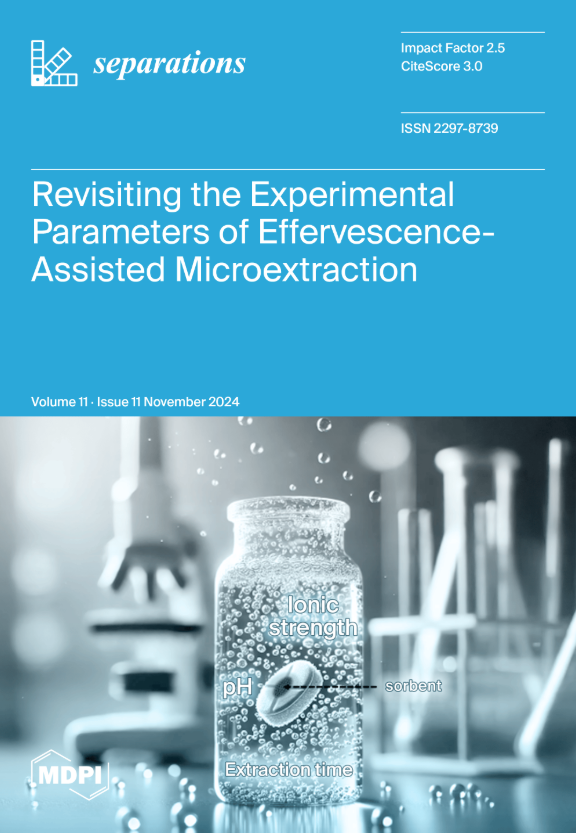Determination of the Relationship between the Granulometry and Release of Polyphenols Using LC-UV, and Their Antioxidant Activity of the Pulp Powder of the Moroccan Argan Tree, “Argania spinosa L.”
IF 2.7
4区 工程技术
Q3 CHEMISTRY, ANALYTICAL
引用次数: 0
Abstract
The bioavailability of cosmetic, pharmaceutical, nutraceutical, and food preparations depends, among other factors, on the galenic form and the control of the granulometric structure of powders. The present study aimed to evaluate the effect of argan pulp powder particle size on functional, physicochemical properties, and antioxidant bioactivity. The particle size study revealed a unimodal particle volume distribution, explaining the regular particle shape. The results relating to functional properties indicated that the critical fraction was in the range of 50–125 µm. However, the study of the particles in each class, evaluated via SEM, showed that the morphology of the pulp powder was strongly dependent on the degree of grinding. The classes in the range of 50–125 µm had the highest polyphenol content, while those of <25 µm had the highest flavonoid content (893.33 mg GAE/100 g DW and 128.67 mg CE/100 g DW, respectively). Molecular analysis via LC and GC-MS showed that particle size had a significant effect on the release of bioactive molecules. ABTS, DPPH, and TAC tests showed that the fraction, ‘‘50–125 µm’’, had the highest antioxidant activity. However, the FRAP test showed highest antioxidant activity for particles of <25 µm. The analysis of the bioactive compounds of the argan pulp powder confirmed a differential distribution, depending on the size of the particles.LC-UV法测定摩洛哥摩洛哥坚果树果肉粉末中多酚类物质的含量与释放量及其抗氧化活性
化妆品、药品、营养保健品和食品制剂的生物利用度,除其他因素外,取决于粉末的百伦形式和颗粒结构的控制。本研究旨在探讨摩洛哥坚果果肉粉末粒度对其功能、理化性质和抗氧化活性的影响。粒径研究揭示了单峰的颗粒体积分布,解释了规则的颗粒形状。功能性能测试结果表明,临界分数在50 ~ 125µm范围内。然而,对每一类颗粒的研究,通过扫描电镜进行评估,表明纸浆粉末的形态强烈依赖于研磨程度。多酚含量在50 ~ 125µm范围内最高,类黄酮含量在<25µm范围内最高,分别为893.33 mg GAE/100 g DW和128.67 mg CE/100 g DW。LC和GC-MS的分子分析表明,颗粒大小对生物活性分子的释放有显著影响。ABTS、DPPH和TAC试验表明,50 ~ 125µm部位抗氧化活性最高。然而,FRAP测试显示,25µm颗粒的抗氧化活性最高。对摩洛哥坚果纸浆粉末的生物活性化合物的分析证实了一种不同的分布,取决于颗粒的大小。
本文章由计算机程序翻译,如有差异,请以英文原文为准。
求助全文
约1分钟内获得全文
求助全文
来源期刊

Separations
Chemistry-Analytical Chemistry
CiteScore
3.00
自引率
15.40%
发文量
342
审稿时长
12 weeks
期刊介绍:
Separations (formerly Chromatography, ISSN 2227-9075, CODEN: CHROBV) provides an advanced forum for separation and purification science and technology in all areas of chemical, biological and physical science. It publishes reviews, regular research papers and communications. Our aim is to encourage scientists to publish their experimental and theoretical results in as much detail as possible. There is no restriction on the length of the papers. The full experimental details must be provided so that the results can be reproduced. There are, in addition, unique features of this journal:
Manuscripts regarding research proposals and research ideas will be particularly welcomed.
Electronic files and software regarding the full details of the calculation and experimental procedure, if unable to be published in a normal way, can be deposited as supplementary material.
Manuscripts concerning summaries and surveys on research cooperation and projects (that are funded by national governments) to give information for a broad field of users.
The scope of the journal includes but is not limited to:
Theory and methodology (theory of separation methods, sample preparation, instrumental and column developments, new separation methodologies, etc.)
Equipment and techniques, novel hyphenated analytical solutions (significantly extended by their combination with spectroscopic methods and in particular, mass spectrometry)
Novel analysis approaches and applications to solve analytical challenges which utilize chromatographic separations as a key step in the overall solution
Computational modelling of separations for the purpose of fundamental understanding and/or chromatographic optimization
 求助内容:
求助内容: 应助结果提醒方式:
应助结果提醒方式:


